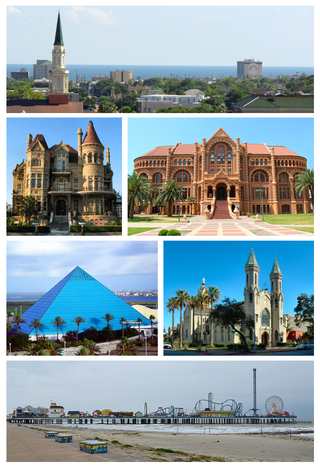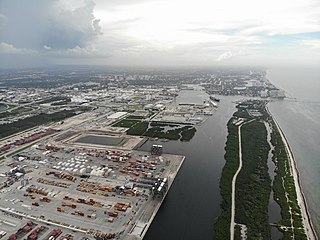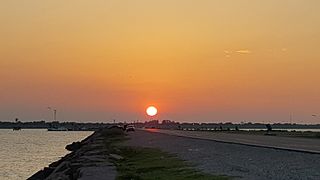| Bayport Container Terminal | |
|---|---|
| Location | |
| Country | United States |
| Location | Pasadena, Texas [1] |
| Coordinates | 29°36′40″N95°0′40″W / 29.61111°N 95.01111°W |
| Details | |
| Opened | 2007 |
| Operated by | Port of Houston Authority |
| Owned by | City of Houston |
| Type of harbour | Natural / artificial |
| Statistics | |
| Website http://www.portofhouston.com | |
The Bayport Container Terminal, or simply the Bayport Terminal, is a major deep water port in the Greater Houston area in Texas (United States). This relatively new terminal, part of the Port of Houston, is designed to handle standardized cargo containers and offload the nearby Barbours Cut Terminal, which has no further room for expansion. [2] The Bayport Terminal is situated along the Bayport Ship Channel off Galveston Bay, between La Porte, Texas and Seabrook, Texas (adjacent to Shoreacres and El Jardin). This channel itself feeds into the larger Houston Ship Channel, which runs from Houston, through Galveston Bay, to the Gulf of Mexico.
The port sits adjacent to the Bayport Industrial District, a large complex of firms primarily involved in petroleum and petrochemical processing.
The facilities at Bayport formerly included a cruise ship terminal, built at a cost of US$81 million. [3] The terminal briefly saw use for cruises following Hurricane Ike when ships like Carnival Cruise Lines Ecstasy and Conquest were re-routed from the damaged Port of Galveston to Bayport for nearly two months. Bayport Cruise Terminal was a planned port of call for both Princess Cruises and Norwegian Cruise Line in 2013-2014. [4] The cruise ships have since abandoned the terminal and the Port of Houston has dismantled the gangways. [5]
The Bayport Terminal was controversial since before its construction due to concerns raised about environmental impact and the general suitability of the site. [6] The United States Army Corps of Engineers approved the permit, but stated in the Environmental Impact Statement that unavoidable impacts of increased noise in the area, increased levels of nitrous oxides, sulfur dioxide, carbon dioxide, and cancer causing particulate matter would be emitted by the terminal. Homes are within 600 feet (180 m) of the docks. [7] Due to the prevailing southeast wind and the proximity of the residents, the Corps of Engineers recommended a 30-foot (9.1 m) sound wall to block sound levels that they estimated to be as high as 70 dBA (as of 2010 the terminal was only approximately 30% in operation yet produced levels of 65 dBA). [8] [9] The Port of Houston approached residents who are affected by the pollution and noise and has attempted to buy an easement from these residents. In 2010, the mayor of Shoreacres published a letter to the community raising concerns about the scope of the easement and rights residents might be waiving by accepting it. [9] [10] That same year residents of Shoreacres filed suit against the Port of Houston Authority for damages. [11] [12]

Galveston is a coastal resort city and port off the Southeast Texas coast on Galveston Island and Pelican Island in the U.S. state of Texas. The community of 209.3 square miles (542 km2), with a population of 53,695 in 2020, is the county seat of surrounding Galveston County and second-largest municipality in the county. It is also within the Houston–The Woodlands–Sugar Land metropolitan area at its southern end on the northwestern coast of the Gulf of Mexico.

La Porte is a city in Harris County, Texas, United States, within the Bay Area of the Houston–Sugar Land–Baytown metropolitan area. As of the 2020 census, the city population was 35,124. La Porte is the fourth-largest incorporated city in Harris County.

Morgan's Point is located 30 miles Southeast of Houston in Southeast Harris County, Texas, United States, located on the shores of Galveston Bay at the inlet to the Houston Ship Channel, near La Porte and Baytown. As of the 2010 census, it had a population of 339. As of 2020, it has approximately 356 residents and is located within the La Porte Independent School District.

Texas City is a city in Galveston County in the U.S. state of Texas. Located on the southwest shoreline of Galveston Bay, Texas City is a busy deepwater port on Texas's Gulf Coast, as well as a petroleum-refining and petrochemical-manufacturing center. The population was 51,898 at the 2020 census, making it the third-largest city in Galveston County, behind League City and Galveston. It is a part of the Houston metropolitan area. The city is notable as the site of a major explosion in 1947 that demolished the port and much of the city.
The Port of Houston is one of the world's largest ports and serves the metropolitan area of Houston, Texas. The port is a 50-mile-long complex of diversified public and private facilities located a few hours' sailing time from the Gulf of Mexico. Located in the fourth-largest city in the United States, it is the busiest port in the U.S. in terms of foreign tonnage and the second-busiest in the U.S. in terms of overall tonnage. Though originally the port's terminals were primarily within the Houston city limits, the port has expanded to such a degree that today it has facilities in multiple communities in the surrounding area. In particular the port's busiest terminal, the Barbours Cut Terminal, is located in Morgan's Point.

Galveston Bay is a bay in the western Gulf of Mexico along the upper coast of Texas. It is the seventh-largest estuary in the United States, and the largest of seven major estuaries along the Texas Gulf Coast. It is connected to the Gulf of Mexico and is surrounded by sub-tropical marshes and prairies on the mainland. The water in the bay is a complex mixture of sea water and fresh water, which supports a wide variety of marine life. With a maximum depth of about 10 feet (3 m) and an average depth of only 6 feet (2 m), it is unusually shallow for its size.

Port Everglades is a seaport in Fort Lauderdale, Florida, located in Broward County. Port Everglades is one of South Florida's foremost economic engines, as it is the gateway for both international trade and cruise vacations. In 2019, Port Everglades was ranked the third-busiest cruise homeport in the world, accommodating more than 3.89 million passengers. It was also one of the busiest container ports in Florida and ranked among the top 20 busiest in the United States, moving more than 1 million TEUs annually.

Port Bolivar is an unincorporated community located on the northern shore of the western tip of the Bolivar Peninsula, separated from Galveston Island by the entrance to Galveston Bay. The Bolivar Peninsula itself is a census-designated place, in Galveston County, Texas, and part of the Houston–Sugar Land–Baytown metropolitan area. The entire peninsula was severely damaged during Hurricane Ike on September 13, 2008; re-building efforts were still continuing as late as 2013.

Buffalo Bayou is a slow-moving body of water which flows through Houston in Harris County, Texas. Formed 18,000 years ago, it has its source in the prairie surrounding Katy, Fort Bend County, and flows approximately 53 miles (85 km) east through the Houston Ship Channel into Galveston Bay and the Gulf of Mexico. In addition to drainage water impounded and released by the Addicks and Barker reservoirs, the bayou is fed by natural springs, surface runoff, and several significant tributary bayous, including White Oak Bayou, Greens Bayou, and Brays Bayou. Additionally, Buffalo Bayou is considered a tidal river downstream of a point 440 yards (400 m) west of the Shepherd Drive bridge in west-central Houston.

The Houston Ship Channel, in Houston, Texas, is part of the Port of Houston, one of the busiest seaports in the world. The channel is the conduit for ocean-going vessels between Houston-area terminals and the Gulf of Mexico, and it serves an increasing volume of inland barge traffic.

The Port of New York and New Jersey is the port district of the New York-Newark metropolitan area, encompassing the region within approximately a 25-mile (40 km) radius of the Statue of Liberty National Monument.

The Port of Galveston is the port of the city of Galveston, Texas, United States. It was established by a proclamation issued by the Congress of Mexico on October 17, 1825, while the land known today as Texas was still part of Mexico. The Port of Galveston is the oldest port in the Gulf of Mexico west of New Orleans.

The Galveston Bay Area, also known as Bay Area Houston or simply the Bay Area, is a region that surrounds the Galveston Bay estuary of Southeast Texas in the United States, within Houston–The Woodlands–Sugar Land metropolitan area. Normally the term refers to the mainland communities around the bay and excludes Galveston as well as most of Houston.

The Texas City Dike is a levee located in Texas City, Texas, United States that projects nearly 5 miles (8.0 km) south-east into the mouth of Galveston Bay. It is flanked by the north-eastern tip of Galveston Island and the south-western tip of the Bolivar Peninsula. The dike, one of the area's most beloved and enduring landmarks, was originally designed to reduce the impact of sediment accumulation along the lower Bay.

The effects of Hurricane Ike in Texas were crippling and long-lasting. Ike's effects included deaths, widespread damage, and impacts to the price and availability of oil and gas. Hurricane Ike also had a long-term impact on the U.S. economy. Making landfall over Galveston, at 2:10 a.m. CDT on September 13, 2008, Category 2 Hurricane Ike caused extensive damage in Texas, with sustained winds of 110 mph (180 km/h), a 22 ft (6.7 m) storm surge, and widespread coastal flooding.

Port Jersey, officially the Port Jersey Port Authority Marine Terminal and referred to as the Port Jersey Marine Terminal, is an intermodal freight transport facility that includes a container terminal located on the Upper New York Bay in the Port of New York and New Jersey. The municipal border of the Hudson County cities of Jersey City and Bayonne runs along the long pier extending into the bay.

The Ike Dike is a proposed coastal barrier that, when completed, would protect the Galveston Bay in Texas, United States. The project would be a dramatic enhancement of the existing Galveston Seawall, complete with floodgates, which would protect more of Galveston, the Bolivar Peninsula, the Galveston Bay Area, and Houston. The barrier would extend across Galveston Island and the Bolivar Peninsula and would provide a barrier against all Gulf surges into the bay. The project is primarily the suggestion of Dr. Bill Merrell of Texas A&M University at Galveston. The Ike Dike would be able to withstand a 10000 year storm.

For a period of over 7000 years, humans have inhabited the Galveston Bay Area in what is now the United States. Through their history the communities in the region have been influenced by the once competing sister cities of Houston and Galveston, but still have their own distinct history. Though never truly a single, unified community, the histories of the Bay Area communities have had many common threads.

The Bayport Industrial District is a large commercial real-estate development located in southeast Harris County, Texas, within the Bay Area of Greater Houston. It is one of the two industrial districts in the extraterritorial jurisdiction of La Porte. It is located adjacent to both La Porte and Pasadena.

The Barbours Cut Container Terminal, or simply the Barbours Cut Terminal, is a major deep water port in the Greater Houston area in the U.S. state of Texas. It is part of one of the world's busiest ports by cargo tonnage.